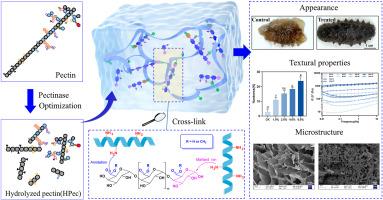Pectin oligosaccharides stabilize sea cucumbers against heat-induced deterioration
IF 11
1区 农林科学
Q1 CHEMISTRY, APPLIED
引用次数: 0
Abstract
Non-enzymatic deterioration limits the deep processing of sea cucumber. This study discovered that pectinase-hydrolyzed tangerine peel effectively inhibits non-enzymatic deterioration in rehydrated sea cucumbers (RSC), with hydrolyzed pectin (HPec) identified as the primary active component. Further optimization revealed that the best treatment conditions were a hydrolysis time of 24 h and a neutral pH, under which RSC exhibited a more intact appearance, superior textural properties, and a denser microstructure. Additionally, HPec treatment significantly reduced the mass loss of RSC during thermal processing. The treated RSC also demonstrated higher water-holding capacity (WHC) and improved moisture retention. Thermal stability tests indicated that HPec-treated RSC had higher protein denaturation and degradation temperatures. Fourier-transform infrared spectroscopy (FTIR) analysis revealed that HPec treatment enhanced hydrogen bonding and hydrophobic interactions in RSC, along with inducing covalent cross-linking. HPec also shifted the secondary structure of RSC collagen from random coils and β-sheets to β-turns. Furthermore, simulation experiments suggested that its mechanism may involve Maillard reaction and amide-mediated protein cross-linking. This research confirms that HPec effectively suppresses non-enzymatic deterioration in RSC, providing a theoretical foundation for its development as a food-grade protein hydrogel stabilizer.

果胶寡糖稳定海参,防止热引起的变质
非酶变质限制了海参的深加工。本研究发现果胶酶水解陈皮能有效抑制再水合海参(RSC)的非酶促变质,其中水解果胶(HPec)为主要活性成分。进一步优化发现,最佳水解条件为水解时间为24 h, pH为中性,在此条件下,RSC具有更完整的外观、优越的质地性能和更致密的微观结构。此外,HPec处理显著降低了RSC在热处理过程中的质量损失。处理后的RSC还表现出更高的持水能力(WHC)和更好的保湿性。热稳定性试验表明,经hpec处理的RSC具有较高的蛋白质变性和降解温度。傅里叶红外光谱(FTIR)分析表明,HPec处理增强了RSC中的氢键和疏水相互作用,并诱导共价交联。HPec还将RSC胶原的二级结构从随机线圈和β-片转变为β-弯。此外,模拟实验表明其机制可能涉及美拉德反应和酰胺介导的蛋白质交联。本研究证实了HPec能有效抑制RSC的非酶促降解,为其作为食品级蛋白质水凝胶稳定剂的开发提供了理论基础。
本文章由计算机程序翻译,如有差异,请以英文原文为准。
求助全文
约1分钟内获得全文
求助全文
来源期刊

Food Hydrocolloids
工程技术-食品科技
CiteScore
19.90
自引率
14.00%
发文量
871
审稿时长
37 days
期刊介绍:
Food Hydrocolloids publishes original and innovative research focused on the characterization, functional properties, and applications of hydrocolloid materials used in food products. These hydrocolloids, defined as polysaccharides and proteins of commercial importance, are added to control aspects such as texture, stability, rheology, and sensory properties. The research's primary emphasis should be on the hydrocolloids themselves, with thorough descriptions of their source, nature, and physicochemical characteristics. Manuscripts are expected to clearly outline specific aims and objectives, include a fundamental discussion of research findings at the molecular level, and address the significance of the results. Studies on hydrocolloids in complex formulations should concentrate on their overall properties and mechanisms of action, while simple formulation development studies may not be considered for publication.
The main areas of interest are:
-Chemical and physicochemical characterisation
Thermal properties including glass transitions and conformational changes-
Rheological properties including viscosity, viscoelastic properties and gelation behaviour-
The influence on organoleptic properties-
Interfacial properties including stabilisation of dispersions, emulsions and foams-
Film forming properties with application to edible films and active packaging-
Encapsulation and controlled release of active compounds-
The influence on health including their role as dietary fibre-
Manipulation of hydrocolloid structure and functionality through chemical, biochemical and physical processes-
New hydrocolloids and hydrocolloid sources of commercial potential.
The Journal also publishes Review articles that provide an overview of the latest developments in topics of specific interest to researchers in this field of activity.
 求助内容:
求助内容: 应助结果提醒方式:
应助结果提醒方式:


